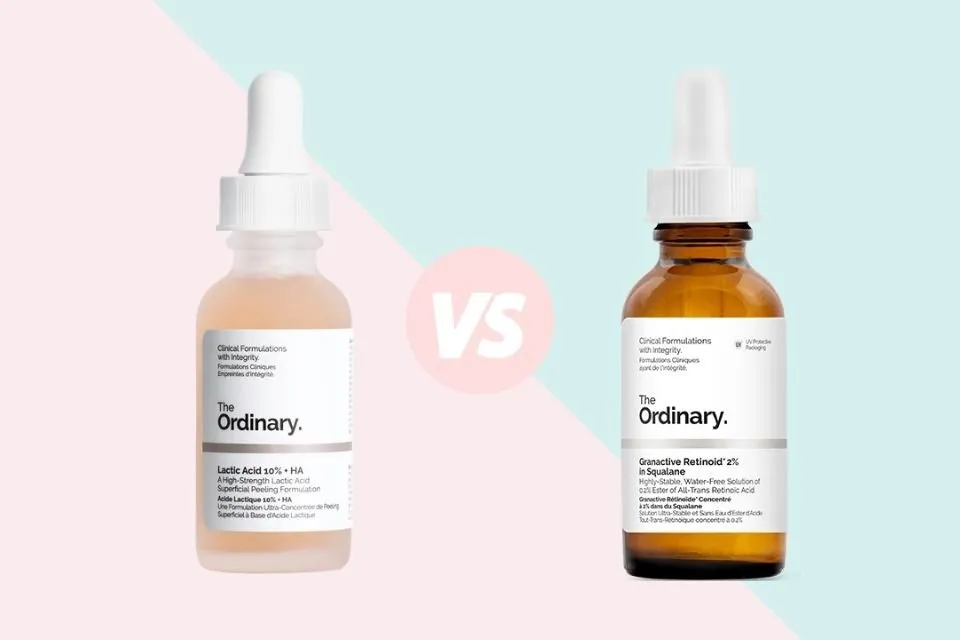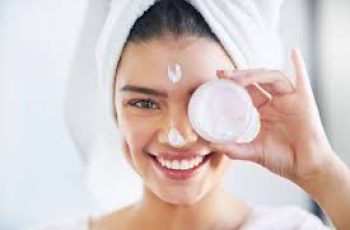Can I Combine Granactive Retinoid with Lactic Acid?
When it comes to skincare, certain ingredients are crucial for maintaining healthy skin. Chemical exfoliants like lactic acid and retinol are undoubtedly two of the most effective actives, known for delivering visible results. With such a vast range of ingredients and formulas available, it can often feel overwhelming to figure out how to layer them correctly. Additionally, it’s important to know which products are compatible and which ones should be avoided altogether.
This post will explore this topic further, focusing primarily on the popular skincare powerhouses—lactic acid and granactive retinoid. Let’s start by examining the benefits each ingredient offers for the skin.
What is Granactive Retinoid?
Granactive retinoid, also referred to as hydroxypinacolone retinoate, is a form of vitamin A and one of the most extensively studied retinoid compounds. Compared to other retinoid derivatives, granactive retinoid is celebrated for offering a wealth of skin benefits with minimal side effects, such as redness, irritation, and peeling, which are often associated with traditional retinol.
Skincare Benefits of Granactive Retinoid
Granactive retinoid stimulates skin cell turnover, leading to a brighter and healthier complexion.
It helps to thicken the skin, enhancing its ability to protect itself from harmful sun exposure.
Granactive retinoid speeds up the skin’s natural exfoliation process, which reduces fine lines and wrinkles while preventing new ones from forming.
It penetrates deeply into the skin, clearing clogged pores of excess sebum, dirt, and bacteria, which can lead to blackheads and breakouts.
Granactive retinoid helps to even out skin tone, making the skin look more radiant while visibly improving signs of hyperpigmentation.
By boosting collagen and elastin production, it promotes firmer, plumper, and smoother skin.
For more in-depth information about other retinoid types, check out our detailed blog posts on Skin School.
What is Lactic Acid?
Lactic acid is widely regarded as one of the gentlest chemical exfoliants within the alpha hydroxy acid (AHA) family. Derived from fermented milk and other dairy products, it offers similar benefits to stronger acids, like glycolic acid, but with a much lower risk of skin irritation. Here are some key benefits of lactic acid for the skin:
Skincare Benefits of Lactic Acid
Lactic acid helps slough off the buildup of dead skin cells, which can contribute to breakouts, blemishes, and congestion.
It improves skin texture, making it firmer and thicker over time.
Lactic acid visibly reduces fine lines and wrinkles, leaving the skin looking smoother.
It acts as a humectant, drawing moisture into the skin and helping to lock it in, which supports a healthy lipid barrier.
Available in various concentrations, from 5% to over 12%, lactic acid allows for customizable results.
Due to its larger molecular size, lactic acid doesn’t penetrate too deeply, which helps avoid unwanted irritation.
Suitable for all skin types, lactic acid provides effective results without causing redness, dryness, or irritation.
For more details on lactic acid, be sure to read our dedicated blog post.
Can I Use Retinol and Lactic Acid Together?
Yes, you absolutely can—but there are some important tips to ensure you get the full benefits of both ingredients without experiencing adverse effects.
The most effective way to use both lactic acid and retinol is by applying them at different times of the day.
Use lactic acid in your morning routine to remove any residue or buildup of skincare products. It will also help prepare your skin for the next steps of your routine, allowing other formulas to absorb more efficiently.
Apply retinol in the evening, allowing it to work uninterrupted by external factors like pollution and UV rays while you sleep.
It’s crucial to use retinol in the evening because sunlight can deactivate retinoids, rendering them ineffective. Additionally, retinol can increase your skin’s sensitivity to the sun, so daily sunscreen with an SPF of 30 or higher is essential to protect your skin.
As your skin builds tolerance to both ingredients, you’ll notice significant improvements in your complexion and overall skin health. However, if your skin is sensitive to the application, consider using these products on alternate days. If you’re new to either ingredient, or if you have concerns, it’s always a good idea to consult a dermatologist or skincare professional to ensure you’re using the right products for your skin’s needs.
Can You Use AHA with Granactive Retinoid?
Yes, it’s possible to use AHA and granactive retinoid together, but you need to be mindful of how you apply them to maximize their benefits. While granactive retinoid is known for being gentle on the skin, it’s still not ideal to layer it directly with acids. This is mainly because the more acidic pH of AHA products can disrupt the skin’s natural acidic environment, potentially causing irritation, redness, dryness, or discomfort.
To avoid this, the most effective method is to apply AHA in the morning and granactive retinoid in the evening. Alternatively, you can use both in the evening, giving your skin enough time to rebalance before continuing with the rest of your skincare routine.
With patience and proper application, you’ll be able to enjoy impressive results. If you have any more questions about layering skincare ingredients or other skin-related concerns, follow us on Instagram for additional tips and advice.
DQH Knowledge drop: In your 20s, your skin cell turnover decreases. (Cell turnover is a key component in keeping your skin youthful.) You know what else slows down? Your collagen production. Starting in your 20s, collagen decreases by about 1 percent per year. Should you want to prevent fine lines and wrinkles, start by eliminating behaviors that contribute to premature aging. “If it’s bad for you, it’s bad for your skin,” says dermatologist Michel Somenek.
“Cigarette smoking reduces blood flow to the skin and causes premature wrinkling and a dull skin texture. Making the repeated pursed motion to inhale can also cause smoker’s lines. Alcohol and recreational drugs are toxins for the skin that damage its cellular structure and DNA,” Somenek tells us. “The faster you eliminate vices while you are young, the better chance your skin and body have to recuperate.” Also, adopting an anti-aging routine in your 20s is key. After all, the best offense is a good defense. We spoke to Somenek and experts Joshua Ross and Audrey Kunin to find out more.
Keep reading for the best anti-aging products for your 20s, according to skincare professionals.
Sunscreen
“We all know that the sun is the number one cause of skin aging and starting the prevention in your 20s is very important,” Ross says. “The majority of your sun damage won’t start to appear until you’re in your 30s, so don’t wait until you see it surface or you’ll be behind the curve. Stay ahead of it with a good-quality zinc-based sunscreen worn daily.”
Farmacy Green Defense Daily Mineral Sunscreen
An invisible sunscreen with SPF 30, plus botanical extracts meant to protect skin with tons of antioxidants. Bonus: It’s clean and fine to use under makeup.
Bareminerals Complexion Rescue™ Tinted Moisturizer Broad Spectrum SPF 30
Although we recommend you use your SPF and moisturizer separately, we also understand moments when you don’t have time or energy for that extra step. For those times, this bareMinerals moisturizer is a great thing to have on hand.
Vitamin C Serum
“A great introduction to anti-aging is to start with a vitamin C serum in your morning skincare routine,” Ross says. “It’s a powerful antioxidant that will neutralize free radicals and brighten the skin.” He adds that it’s a great way to counteract the effects of the sun’s harmful rays, which, as previously mentioned, are among the biggest causes of premature aging.
Drunk Elephant C-Firma™ Vitamin C Day Serum
The Drunk Elephant C-Firma is a lightweight serum that promises to give skin a glow by combining the brightening powers of vitamin C with ferulic acid, l-ascorbic acid, and vitamin E. The included sodium hyaluronate is meant to replace hydration loss, so you shouldn’t have to deal with any irritation.
Sunday Riley C.E.O. Rapid Flash Brightening Serum
This potent serum is jam-packed with vitamin C (15 percent, to be exact), which means it’s a potential superstar at both brightening skin and dousing it in antioxidants.
Peptides
Using peptides on your skin has many benefits, says Somenek. “The skin barrier is what defends the body against pollution, UV rays, bacteria, and toxins. It can be damaged by several everyday factors. Using topical peptides aids in building a stronger barrier,” he says. “Peptides comprise elastic fibers, which are a type of protein. These fibers help to make skin appear taut and firm. Peptides can also help repair damaged skin, relieve inflammation, and even out skin tone. Some peptides can kill acne-causing bacteria that is common in 20-somethings.”
Kunin agrees, saying, “Peptides are an excellent entry point for supporting collagen.” She recommends looking for face and eye treatments that contain these collagen-boosting powerhouses.
Charlotte Tilbury Magic Eye Rescue Cream
This Charlotte Tilbury super-emollient eye cream has a base of coconut oil and shea butter (read: it’s incredibly hydrating). Botanicals plus peptides are meant to help reduce dark circles and boost collagen, respectively.
This creamy moisturizer serves up potent collagen-boosting peptides and pycnogenol, and antioxidant-rich vitamin C. “Instead of sitting on top of the skin, peptides penetrate the outer layer so they go deep. The ‘signals’ they send tell the cells to produce elastin and collagen, which are needed for youthful-looking skin,” explains Somenek.
At-Home Peel Pads
Remember that skin cell turnover fiasco we talked about earlier? One way to help support it is by exfoliating. “Exfoliation is important to help keep skin fresh and luminous,” Kunin says. She recommends using at-home peel pads as an easy and effective way to exfoliate.
“The goal in your 20s is to fight the slowing pace of cell turnover. It is wise to use products that gently exfoliate, yet still remove oil and other impurities. Products that have Alpha Hydroxy Acids (AHA) or Beta Hydroxy Acids (BHA) are a good choice.”
According to Somenek, you should only exfoliate two to three times a week. “People of all ages are guilty of over-exfoliating and that can be too much of a good thing,” he says.
Dermadoctor Kakadu C Intensive Vitamin C Peel Pad
A few swipes of this Derma Doctor powerful peel pad promise to leave your skin glowing and smooth, thanks to the seven (yes, seven) types of chemical exfoliants, including AHA and BHA. It also contains vitamin C via Kakadu plum extract for added brightening and antioxidant protection.
KEY INGREDIENTS Kakadu plum extract is sourced from the Kakadu plum, a fruit grown in northern Australia. It contains vitamin C, which restores the skin’s natural barrier, increases collagen production, and soothes irritation.
Dr. Dennis Gross Skincare Alpha Beta® Universal Daily Peel Pads
These are the gold standard of peel pads, with a cult following and over 900 five-star reviews on Sephora. They’re easy to use and contain a blend of anti-aging exfoliating acids.
Emollient Night Cream
“In your 20s, you need to start upping the hydration in your skincare routine. You may have been cautious of over-moisturizing because of acne in your teens, but as you enter your 20s, your skin transitions and becomes drier,” Ross says. “I recommend an emollient night cream added into your evening skincare regimen.”
“Twenty-somethings need to make sure that they are not using creams that will clog their pores and cause excess oil production,” says Somenek. Opt for non-comedogenic products.
Cerave Skin Renewing Night Cream
One great choice is the CeraVe Skin Renewing Night Cream, which is a non-comedogenic night cream that leaves skin soft and glowy. It combines the moisturizing powers of ceramides and hyaluronic acid.
RoC Retinol Correxion Max Hydration Creme
“The best night cream ingredients contain retinol, benzoyl peroxide, and/or salicylic acid or hyaluronic acid. The goal is to moisturize, yet remove excess oil,” says Somenek. This Roc Retinol Correxion cream fits the bill as it contains both hyaluronic acid and retinol so it promises to moisturize while also being non-comedogenic.



